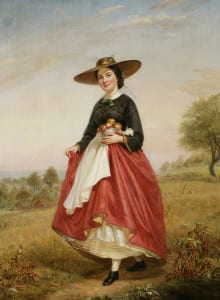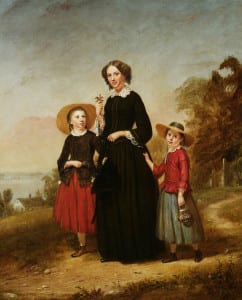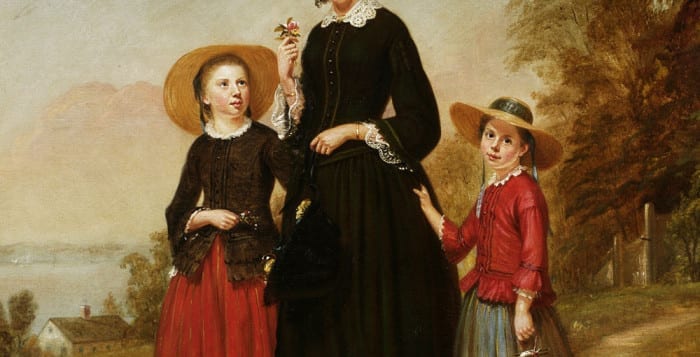By Ellen Barcel
Today, youngsters all seem to be tied to websites, texting, apps and more. They’ve got their headphones on and download the latest music. Until recently, children had to make do without electricity. They played games (nonelectronic), enjoyed music (which people had to make themselves) and danced. School didn’t feature “smart” classrooms.

While children today have chores, in the agrarian past children’s jobs were very different: They gathered eggs from their chickens, went fishing and trapping and helped hang the laundry out on the clothesline. Gender conventions were stronger then. Girls played with dolls and boys with trains.
To provide a glimpse into early 19th-century children’s lives on Long Island, the Long Island Museum of American Art, History and Carriages in Stony Brook has opened a new exhibit, “Young Island,” showing a collection of William Sidney Mount’s paintings that depict children’s lives in the years before, during and just after the Civil War.
Mount was a 19th-century Setauket artist who is known for his paintings of everyday life. In an age before the camera, he also did portraits, many of children. “Catherine Adele Smith,” “Maria Winthrop Seabury,” “Young Girl” and “Tutie [Ruth Hawkins Mount]” are all examples of those many portraits, all part of the current exhibit.
Children teased and played around — yes, they were naughty then too, shown in “Mischievous Drop” and “Boys Wrangling,” and they had work to do. “Returning from the Orchard” shows a young girl who has gathered fruit, “Catching Rabbits” shows boys emptying a trap, and “Boy Hoeing Corn” shows a child working in the field.
The idea for the exhibit was Joshua Ruff’s, director of collections and interpretation. “The idea came from the fact that we often have a Mount exhibit, especially during the school year … We’ve never done an exhibit with children before so it seemed like a good fit,” said Julie Diamond, director of communications at the museum.
“It’s an easy theme to recognize for Mount … when you look through the several thousand drawings we own as well as the more than one hundred oil paintings, children play a significant role in both his genre and portraiture. Mount himself was surrounded by children in daily life, living under the same roof as both of his brothers’ large families. He had many nieces and nephews,” said Ruff.
“Children are featured in his work in a myriad of ways — representing innocence, a young nation’s optimism, political points etc. Since this was also a time that children worked extensively on the American/Long Island farm, there’s that element too. Mount is like a fair number of other American artists of the 19th century — Winslow Homer, Eastman Johnson and others — who are using children in both allegorical and realistic ways in their work. So it’s a great theme to explore, even in a fairly small exhibit such as this,” he added.

Selecting the works to be included in the exhibit was a challenge. “Choice of the work was not easy,” said Ruff. “There are literally dozens of excellent drawings and paintings that could have been included, but this is our smaller gallery, so space only allows 18 works,” especially since many of Mount’s paintings are large.
Ruff continued, “I wanted to choose a range of both drawings and paintings, so we have five of the former, 13 of the latter. In some cases, these are works that we have not had out in a while — ‘Boys Snowballing,’ ‘Walking Out,’ and a few more have not been on view for some time. In other cases, such as ‘Girl Sleeping’ and ‘Turning the Leaf’ — these are some of Mount’s best-known works, but are usually not interpreted this way. ‘Turning the Leaf’ is also supported in this exhibit by a lovely small preliminary study Mount did for that painting.”
One of the best known of Mount’s works is “Dance of the Haymakers,” which shows workers in a barn dancing to a fiddler’s music. Outside, a small boy beats time to the music on the side of the barn with sticks. A dog lays on the ground and farm tools are propped up against the side of the barn.
“We wanted to show ‘Dance,’ not only because it relates to the theme, but also because it is going out on national loan to the Detroit Institute of Arts next year. One of the most important aspects of this exhibit for us is that we will be able to use it very well with our educational programming,” said Ruff.
Diamond added that the LIM has programs for school groups, one geared for kindergarten through second grade and another for fourth through sixth grade. “Both use the Mount exhibit as the basis for learning,” about American history.
“Also, it is a very good little family show. In addition to the regular labels/text, there are also labels for families. We hope that it will give people a chance to think about a side of Mount that they may not have considered much before,” said Ruff.
While at the LIM, visit some of its other exhibits, including Hooked@LIM, an outdoor exhibit of yarn bombing, the herb garden, “Gilding the Coasts: the Art and Design of Long Island’s Great Estates” and “Beth Levine: The First Lady of Shoes.”
“Young Island” is scheduled to run through the end of the year. The LIM, a Smithsonian affiliate, is located in Stony Brook at 1200 Route 25A. It is open Thursday through Saturday, 10 a.m. to 5 p.m., and Sunday, noon to 5 p.m. For further information, call 631-751-0066 or visit www.longislandmuseum.org.





